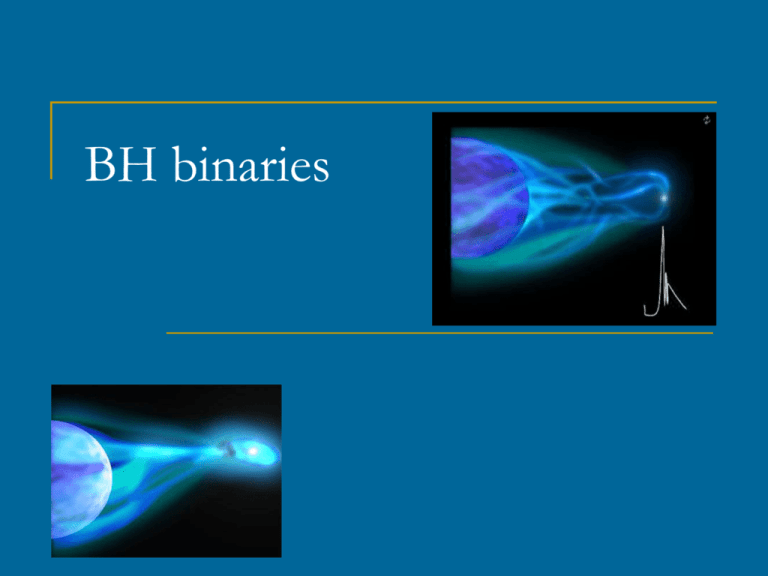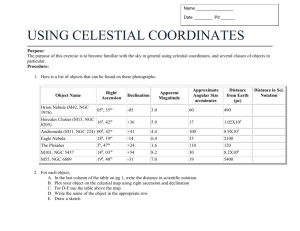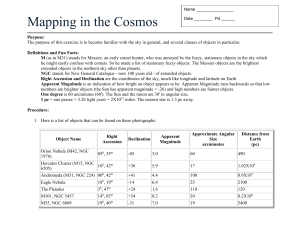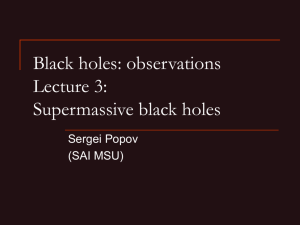X-ray binaries
advertisement

BH binaries Black hole binaries • High mass (few) • Low-mass (majority) • ULX – ultraluminous X-ray sources Most of low-mass are transients. Microquasars. A hope for PSR+BH binary • Either due to evolution (one per several thousand normal PSRs) • Either due to capture (then – few in the central pc, see arXiv: 1012.0573) X-ray observations: Cyg X-1 “In the case of Cyg X-1 black hole – is the most conservative hypothesis” Edwin Salpeter The history of exploration of binary systems with BHs started about 40 years ago... X-ray novae Low-mass binaries with BHs One of the best candidates In the minimum it is possible to see the secondary companion, and so to get a good mass estimate for a BH. BH candidates Among 20 good galactic candidates 17 are X-ray novae. 3 belong to HMXBs (Cyg X-1, LMC X-3, GRS 1915+105). New candidates still appear. For on of the latest see 1008.0597 (J. Orosz, from astro-ph/0606352) Candidates properties (astro-ph/0606352) Also there are about 20 “candidates to candidates”. Quescent luminosity vs. Orbital period Open symbols – neutron stars black symbols – black holes. (Garcia et al. 2001, see Psaltis astro-ph/0410536) Red – NS systems. Blue – BHs. arXiv: 1105.0883 Distance to V404 Cyg The parallax was measured. The new distance estimate is 2.25-2.53 kpc. It is smaller than before. Correspondently, flares luminosity is lower, and so they are subEddington. arXiv:0910.5253 Mass determination here mx, mv - masses of a compact object and of a normal (in solar units), Kv – observed semi-amplitude of the line of sight velocity of the normal star (in km/s), P – orbital period (in days), e – orbital eccentricity, i – orbital inclination (the angle between the line of sight and the normal to the orbital plane). As one can see, the mass function of the normal star is the absolute lower limit for the mass of the compact object. The mass of the compact object can be calculated as: So, to derive the mass of the compact object in addition to the line of sight velocity it is necessary to know independently two more parameters: the mass ratio q=mx/mv, and the orbital inclination i. Black hole masses The horizontal line corresponds to the mass equal to 3.2 solar. (Orosz 2002, see also Psaltis astro-ph/0410536) Some more recent records Paredes arXiv: 0907.3602 M33 X-7 15.65+/-1.45 Msolar (Orosz et al. 2007). Eclipsing binary IC10 X-1 32+/- 2.6 (Silverman and Filippenko 2008) Systems BH + radio pulsar: a Holy Grail The discovery of a BH in pair with a radio pulsar can provide the most direct proof of the very existence of BHs. Especially, it would be great to find a system with a millisecond pulsar observed close to the orbital plane. Computer models provide different estimates of the abundance of such systems. Lipunov et al (1994) give an estimate about one system (with a PSR of any type) per 1000 isolated PSRs. Pfahl et al. (astro-ph/0502122) give much lower estimate for systems BH+mPSR: about 0.1-1% of the number of binary NSs. This is understandable, as a BH should be born by the secondary (i.e. initially less massive) component of a binary system. Jet from GRS 1915+105 VLA data. Wavelength 3.5 cm. (Mirabel, Rodrigez 1994, see Psaltis astro-ph/0410536) T~107 K M-1/4 – last stable orbit temperature at Eddington luminosity Optics/UV – QSO X-ray - μQSO States (luminosity+spectrum+jet+variability) The understanding that BH binaries can pass through different “states” (characterized by luminosity, spectrum, and other features, like radio emission) appeared in 1972 when Cyg X-1 suddenly showed a drop in soft X-ray flux, rise in hard X-ray flux, and the radio source was turned on. Now there are several classifications of states of BH binaries. astro-ph/0306213 McClintock, Remillard Black holes on binary systems Spectra of BH candidates XTE 1118+480 (Psaltis astro-ph/0410536) Different components of a BH spectrum Accretion geometry and photon paths at the hard state 0909.2567 1104.0097 Three-state classification In this classification the luminosity is not used as one of parameters. (Remillard, McClintock astro-ph/0606352) Discs and jets The model for systems with radio jets LS – low/hard state HS – high/soft state VHS/IS –very high and intermediate states The shown data are for the source GX 339-4. (Fender et al. 2004, Remillard, McClintock astro-ph/0606352) Hardness vs. flux: state evolution 0909.2474 GRO J1655-40 during a burst Red crosses – thermal state, Green triangles – steep power-law (SPL), Blue squares – hard state. (Remillard, McClintock astro-ph/0606352) 4U 1543-47 and H1743-322 (Remillard, McClintock astro-ph/0606352) XTE J1550-564 and XTE J1859-226 Recent large set of data RXTE data 25 LMXBs 0912.0142 Hardness Intensity Diagram (HID) and Disc Fraction Luminosity Diagram (DFLD) LEFT: HID with specific disc fractions highlighted RIGHT: DFLD with specific X-ray colours highlighted. The highlighted disc fractions are red 0.3, orange 0.1, yellow 0.03; and the highlighted X-ray colours are cyan 0.3, green 0.2, blue 0.1. TOP: GX 339-4, DOWN: GRO 1655-40 Summary of states with jets in BH binaries http://www.issibern.ch/teams/proaccretion/Images/newcomplete_72dpi.png NS jets 1104.1115 QPO BH candidates demonstrate two main types of QPOs: Low-frequency (0.1-30 Hz) and high-frequency (40-450 Hz). Low-frequency QPOs are found in 14 out of 18 objects. They are observed during different states of sources. Probably, in different states different mechanisms of QPO are working. High-frequency QPOs are known in a smaller number of sources (7). It is supposed that frequencies of these QPOs correspond to the ISCO. QPO and flux from a disc SPL – green triangles Hard – blue squares Intermediate states – black circles Low-frequency QPOs (their frequency and amplitude) correlate with spectral parameters. Probably, QPO mechanisms in the hard state and in the SPL state are different. (Remillard, McClintock astro-ph/0606352) QPO at high (for BHs) frequency All QPO at >100 Hz are observed only in the SPL state. Blue curves: for the range 13-30 keV. Red curves: for a wider range (towards lower energies). (Remillard, McClintock astro-ph/0606352) QPOs and BH masses XTE J1550-564, GRO J1655-40, GRS 1915+105 Dashed line is plotted for the relation ν0 = 931 Hz (M/MO)-1 The ordinate shows 2ν0 (Remillard, McClintock astro-ph/0606352) Inner disk boundary In BH binaries there are different spectral and luminosity states. It was suggested that the inner disk boundary moves significantly from stage to stage. For the first time the effect is measured thanks to iron line data. At low luminosity the inner disk boundary is far from the BH. 0911.2240 Position of the inner disc boundary is clearly different at different luminosities: from 0.1 to 0.001 LEdd. In a separate paper another group of scientists put constraints on the spin rate of the BH in this system. GX 339–4 Ultraluminous X-ray sources ULXs are sources with fluxes which correspond to an isotropic luminosity larger than the Eddington limit for a 10 solar mass object. Now many sources of this type are known. Their nature is unclear. Probably, the population contains both: stellar mass BHs with anisotropic emission and intermediate mass BHs. ULXs in NGC 4490 and 4485 Six marked sources are ULXs Spectrum of the ULX in NGC 1313 NGC 1313 X-1 Green line – the IMBH model. Red – power-law. Blue – multi-color disc. (arXiv 0706.2562) ULX in galaxies of different types In the following two slides there are images of several galaxies from the SDSS in which positions of ULXs are marked. Crosses (x) mark sources with luminosities >1039 erg/s. Pluses (+) mark sources with luminosities >5 1038 erg/s. The size of one square element of the grid is 1.2 arcminute (except IZW 18, in which case the size is 0.24 arcminute in right ascension and 0.18 in declination). Galaxies NGC 4636, NGC 1132, NGC 4697, NGC 1399 are ellipticals, IZW 18 – irregular, the rest are spiral galaxies. Ellipses mark the 25-th magnitude isophotes (this a typical way to mark the size of a galaxy). ULX in galaxies of different types IZW 18 NGC 1132 NGC 253 NGC 1291 IC 2574 NGC 1399 ULX in galaxies of different types NGC 2681 NGC 3184 NGC 4697 NGC 4631 NGC 4636 The source X-1 in М82 The source M82 X-1 is one of the most luminous, and so it is the best candidate to be an intermediate mass BH. QPOs are observed in this source. Their properties support the hypothesis of an intermediate mass BH. М82, stellar clusters and ULXs Intermediate mass BHs can be formed in dense stellar clusters. See, however, 0710.1181 where the authors show that for solar metallicity even very massive stars most probably cannot produce BHs massive enough. McCrady et al (2003) http://www.nature.com/nature/journal/v428/n6984/full/nature02448.html X41.4+60 in M82 79-day burst. Isotropic luminosity ~5 1040 erg/s Hard state. Usually L~0.3 Ledd, here there are indications (photon index Γ= 1.6) that it is even ~0.1 Ledd. QPOs. Altogether: mass ~ few 1000 Solar. RXTE + Chandra observations (Kaaret et al. 0810.5134) The most luminous ULX: HLX-1 in the galaxy ESO 243-49, L>1042 erg/s M~500MO 1011.1254, 1104.2614 IMBH in an ULXs 0911.1076 For the first time for one source there are both – spectral and timing – data showing evidence in favor of an IMBH. MBH ~ 103 – 104 Msolar Low-frequency QPO (2008 data) NGC 5408 X-1 behaves very much like a Galactic stellar-mass BH system with the exception that its characteristic X-ray time-scales are 100 times longer, and its luminosity is greater by a roughly similar factor. E>1 keV Comparison of two observations Obs1 – 2006 Obs2 – 2008 Obs1-Obs2 Orbital period 115 days 0911.1339 The population of ULXs Most probably, the population of ULXs in not uniform. 1. 2. 3. 4. Intermediate mass BHs Collimated emission from normal stellar mass BHs Different types of sources (pulsars, SNR, contamination) Background sources. The population can grow significantly (~500-600 new candidates) due to new surveys, like 2XMM slew survey (arXiv: 1011.0398), and some other projects (arXiv: 1002.4299). List of reviews • Catalogue of LMXBs. Li et al. arXiv:0707.0544 • Catalogue of HMXBs. Li et al. arXiv: 0707.0549 • Modeling accretion: Done et al. arXiv:0708.0148 • Galactic BH binaries: Paredes arXiv: 0907.3602 • BH states: Belloni arXiv: 0909.2474; Dunn et al. arXiv: 0912.0142 • X-ray BH binaries: Gilfanov arXiv: 0909.2567 • X-ray observations of ULXs. Roberts. arXiv:0706.2562 ULX 1002.4299 1003.0283 1011.0398 1101.5387









